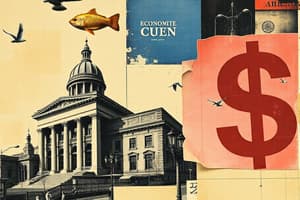Podcast
Questions and Answers
What is the difference between short-run profit maximization and long-run profit maximization?
What is the difference between short-run profit maximization and long-run profit maximization?
Short-run profit maximization focuses on minimizing costs while maximizing output with fixed factors. Long-run profit maximization focuses on maximizing output with adjustments to all inputs, including plant size and capital investment.
Which of the following is a fixed cost?
Which of the following is a fixed cost?
- Rent of a factory (correct)
- Wages of workers
- Raw materials
- Electricity bill
What is the definition of marginal cost?
What is the definition of marginal cost?
Marginal cost is the additional cost incurred when producing one more unit of output.
What is a cartel?
What is a cartel?
What is the key difference between perfect competition and monopolistic competition?
What is the key difference between perfect competition and monopolistic competition?
Explicit costs are payments made directly by the firm, while implicit costs are the opportunity costs of using resources already owned by the firm.
Explicit costs are payments made directly by the firm, while implicit costs are the opportunity costs of using resources already owned by the firm.
What is the main goal of competition law?
What is the main goal of competition law?
In a perfectly competitive market, firms are price takers, meaning they cannot influence the market price.
In a perfectly competitive market, firms are price takers, meaning they cannot influence the market price.
What is economic profit?
What is economic profit?
Which of the following is NOT a characteristic of a perfectly competitive market?
Which of the following is NOT a characteristic of a perfectly competitive market?
Flashcards
Production Function
Production Function
The economic process of transforming inputs into outputs, explaining how businesses decide the quantities of outputs to produce in response to demand.
Production Theory
Production Theory
The relationship between the quantity of inputs used and the quantity of outputs produced. It shows how much output can be generated from a given amount of inputs.
Short-run Cost Minimization
Short-run Cost Minimization
A key decision businesses make in the short run, aimed at using the right quantities of variable inputs to minimize costs while keeping fixed inputs unchanged.
Short-run Profit Maximization
Short-run Profit Maximization
Signup and view all the flashcards
Marginal Revenue (MR)
Marginal Revenue (MR)
Signup and view all the flashcards
Marginal Cost (MC)
Marginal Cost (MC)
Signup and view all the flashcards
Long-run Profit Maximization
Long-run Profit Maximization
Signup and view all the flashcards
Law of Diminishing Marginal Returns
Law of Diminishing Marginal Returns
Signup and view all the flashcards
Total Variable Cost (TVC)
Total Variable Cost (TVC)
Signup and view all the flashcards
Total Fixed Cost (TFC)
Total Fixed Cost (TFC)
Signup and view all the flashcards
Total Cost (TC)
Total Cost (TC)
Signup and view all the flashcards
Average Variable Cost (AVC)
Average Variable Cost (AVC)
Signup and view all the flashcards
Average Fixed Cost (AFC)
Average Fixed Cost (AFC)
Signup and view all the flashcards
Average Total Cost (ATC)
Average Total Cost (ATC)
Signup and view all the flashcards
Marginal Cost (MC)
Marginal Cost (MC)
Signup and view all the flashcards
Pure Competition
Pure Competition
Signup and view all the flashcards
Perfectly Competitive Market
Perfectly Competitive Market
Signup and view all the flashcards
Monopoly
Monopoly
Signup and view all the flashcards
Oligopoly
Oligopoly
Signup and view all the flashcards
Monopsony
Monopsony
Signup and view all the flashcards
Oligopsony
Oligopsony
Signup and view all the flashcards
Explicit Cost
Explicit Cost
Signup and view all the flashcards
Implicit Cost
Implicit Cost
Signup and view all the flashcards
Accounting Profit
Accounting Profit
Signup and view all the flashcards
Economic Profit
Economic Profit
Signup and view all the flashcards
Cartels
Cartels
Signup and view all the flashcards
Philippine Competition Act (PCA)
Philippine Competition Act (PCA)
Signup and view all the flashcards
Study Notes
Economic Costs and Profit
- Firms aim to maximize profit, defined as total revenue minus total costs.
- Total revenue is the price per unit multiplied by the quantity sold.
- Total cost consists of variable costs (costs that change with production) and fixed costs (costs that do not change with production).
- A firm's revenue depends on demand for its product.
Two Types of Costs
- Explicit costs: Out-of-pocket payments made by the firm (e.g., wages, rent).
- Implicit costs: The opportunity cost of using resources already owned by the firm (e.g., using a building you own for a business instead of renting it out).
Accounting Profit vs Economic Profit
- Accounting profit: Total revenue minus explicit costs.
- Economic profit: Total revenue minus all costs (explicit and implicit). This includes the opportunity cost of forgone alternatives. Economic profit helps determine a business's success.
Monopsony and Oligopsony
- Monopsony: A market with only one buyer for a product or service.
- Oligopsony: A market with only a few buyers for a product or service.
- These situations can give buyers significant market power, allowing them to potentially influence prices and production decisions.
Theory of Cost and Profit
- All firms strive to earn profits.
- Profit equals total revenue minus total costs.
Studying That Suits You
Use AI to generate personalized quizzes and flashcards to suit your learning preferences.




